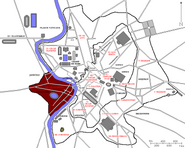Rome is divided up into fourteen regio (regions) identified by a number. The citizens of Rome named the regio by their most prominent feature.
- I - Porta Capena
This district marks the former southern boundary of Rome's ancient Servian Walls. The Porta Capena (Gate to Capua) opens onto the Appian Way, the great road leading to the southern tip of Italy. Largely commercial in nature, its many shops, tabernae (taverns), and cauponae (inns) cater to travelers bound for points far and wide. Tenement housing is marginally safer and better than the warehouses of Regio XIII.
- II - Caelimontium
One of the fabled seven hills, the residential Caelian Hill regio contains among the most exclusive real estate in the city. Patrician families keep their sprawling villas and palaces upon its wooded slopes. The Servian Walls and a smaller Praetorian Guard fort for non-citizen soldiers ensure the peace of Regio II.
- III - Iseum
Romans named the third district after the Temple of Isis, whose popular cult spread during the age of Cleopatra and Julius Caesar. Iseum has a thoroughly cosmopolitan character, the thriving neighbourhood of scribes, traders in cloth and spice, and Greek and Egyptian expatriates laid out along the Via Labicana.
- IV - Via Sacra
Regio IV is synonymous with the oldest and most important road in Rome. The Sacred Way is the main route into the Forum. A microcosm of the city itself, the district is a setting for holy and mundane business. Victorious generals stage their triumphs and officials dispense justice in shadow of the Temple of Vesta. Numerous markets and festival halls, tiny cauponae (inns) and the enormous Basilicas of Julius and Aemilius.
- V - Esquiliae
Rome's most diverse district sprawls over Esquiline Hill. The western Carinae neighbourhood into an opulent hotbed for the intelligentsia. Stately townhouses, lavish gardens, and a thriving market speak to the area's wealth. Ancient laws required burials beyond the city walls and cemeteries dominate the squalid eastern reaches.
- Subura
Subura's filthy slums and rickety tenement buildings are a world unto themselves. The poorest, hardest, and most desperate citizens live in this rat's nest of alleys where even legions fear to tread.
- VI - Alta Semita (Quirinalis)
Alta Semita, the "High Road," winds around the exclusive Quirinal Hill area. Huge hortae (gardens) conceal the mansions of Rome's richest patricians. Regio VI literally stands above the cares of lesser, poorer people.
- VII - Via Lata
This district straddling the Hill of Gardens is the point of departure for all northbound traffic. Imperial landmarks stand among its bustling markets and lively entertainment district. Via Lata leads directly to Campus Martius and the Tiber.
- VIII - Forum Romanum
The Roman Forum is heart of the Empire, the center of the known world. Temples and official buildings stand beside countless statues, shrines, and monuments dedicated to great figures of the past. Senators and slaves, the Imperial family and thieves all gather on the square.
Capitoline Hill
The smallest and highest of the Seven Hills, the Capitoline overlooks the Forum. Its summits are home to an ancient fortress and the city's most sacred shrines. Civic government operates out of the Tabularium on its front slope.
- IX - Circus Flaminius
Rome's second circus holds more obscure ludi (public games) and regular races. The regio is wholly a plebeian district, cobbled together from small shops and a thriving produce market.
- X - Palatium
Regio X straddles Palatine Hill, the most prestigious real estate in the empire. Coveted villas owned by the Imperial family and its supporters stand out among the civic buildings.
- XI - Circus Maximus
The heart of the entertainment district is Circus Maximus. Regio XI contains the empire's largest hippodrome, a stadium for horse and chariot racing. Mobs descend for ludi (public games for festivals) and riots are common. The Forum Boarium, the major livestock market, adds to the chaos. A major fire broke out in 36.
- XII - Piscina Publica
The public reservoir giving Regio XII its colloquial name anchors a neighbourhood of mixed commercial and residential use. Plebeians are slowly transforming the fields and shrunken lake by building more houses.
- XIII - Aventinus
Aventinus drives the city's engines of industry and commerce. Waterfront docks feed the enormous granaries and storehouses gathered on the Tiber. Sailors, slaves, and merchants abound on its streets. Regio XIII is a place of manual labour and dizzying activity, day or night.
- XIV - Transtiberim
The regio covers the left bank of the Tiber River and the Tiber Island. This popular district contains workshops and warehouses, the Jewish neighbourhood, and a massive temple campus dedicated to Aesculapius, god of healing.


